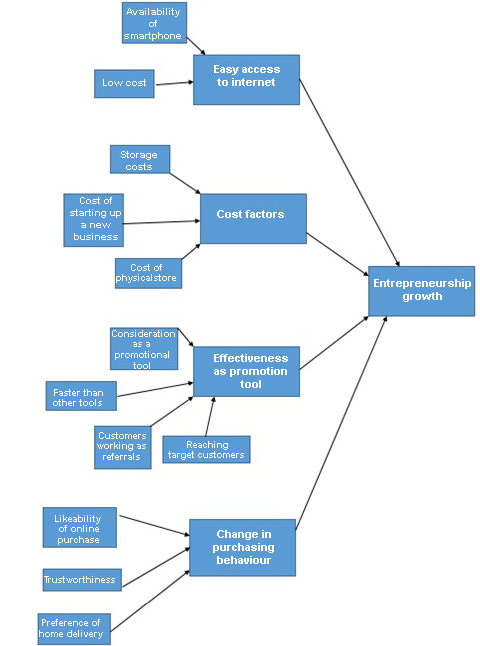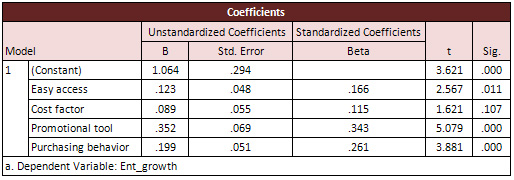|
Web
based Entrepreneurship via Social
Networking Sites: Bangladesh Perspective

Abdul Momen (1)
Seyama Sultana (2)
(1) Dr. Md. Abdul Momen, Department
of Business Administration, East West
University, Dhaka, Bangladesh
(2) Dr. Seyama Sultana , School of
Business and Economics, United International
University, Dhaka, Bangladesh
Corresponding Author:
Dr. Md. Abdul Momen
Department of Business Administration,
East West University,
Dhaka, BangladeshCell phone: 01911302318
Email: a.momen@ewubd.edu

Abstract
The utilization of social networking
sites (SNS) by business visionaries
is developing more quickly than at
no other time throughout the world.
Bangladesh is not a special case.
Hence the components that assume the
most contributing parts for online
business visionaries who utilize a
social networking site should have
been found. The aim of this paper
is to decide the relationship between
social networking sites and business
enterprise. Close to that, the study
has attempted to discover the SNS’s
important components that influence
these business visionaries. A comprehensive
survey was conducted to gather information
from the business visionaries who
lead their business by utilizing social
networking sites. The business people
were haphazardly chosen from all over
Bangladesh. The results demonstrated
that the significant factors which
influence entrepreneurship are “easy
access to the internet,” “effectiveness
as a promotional tool” and “purchasing
behavior” but another factor
that does not affect enterprise significantly
is the “cost factor.” On
the contrary for the betterment and
the prosperity of the economy of the
country, it needs young, self-motivated,
creative entrepreneurs. This paper
provides the fundamental principles
for them with the goal that they can
make sense of the noteworthy components
to consider and disregard the unimportant
in the field of SNSs and online business
enterprise.Key words: Social networking
sites, entrepreneurship,
Bangladesh
Please cite
this article as: Seyama Sultana, Abdul
Momen. Web based Entrepreneurship
via Social Networking Sites: Bangladesh
Perspective. Middle East Journal of
Business. 2018; 13(1):5-11. DOI: 10.5742/MEJB.2018.93187

Introduction
By
utilizing social networking sites
people and gatherings associate and
impart information all through the
world. In the decade of data framework,
social networking sites have assumed
a fundamental part in changing business
and correspondence (Haque et al.,
2013). A portion of the sites are
Facebook, Twitter, MySpace, Whatsapp,
and so forth. One of the speediest
approaches to growing a business’
substance is through social networking
sites (Livingstone and Brake, 2009).
Some social networking sites have
emerged to ease interaction between
and among the people who have a common
interest in and want to share education,
music, and movies and so on (Valkenburg
et al., 2006). All these radical changes
in the social environment likewise
influence the method for business
people to direct their business and
advertisements and other special exercises.
Bangladesh is very nearly achieving
the digital age. The vision of “Digital
Bangladesh” of the legislature
has improved the appropriation of
the web and online networking. Thus,
new doors have been opened to investigate
new parts of working together. In
the previous couple of years (2013-2015)
business through the informal organization
has turned out to be to a great degree
well known among the young entrepreneurs
(Sultana &Momen, 2017). Simplicity
of beginning any new business is by
all accounts not the only reason,
yet interpersonal interaction destinations
are quickly getting acknowledgment
as limited time devices in the nation
and is another significant explanation
behind the specific utilization of
these sites by business visionaries
(Begum, 2003). Regardless of its engaging
quality, a few people wind up ineffective
because of their lack of data about
the buying conduct of purchasers.
Another huge test is the unscrupulous
specialists who are taking focal points
of this field by abusing the online
purchasers and who are similarly hurtful
to online purchasers. To give noteworthy
data to the concerned gatherings including
government, this study has attempted
to decide the contributing components
to further the prosperity of this
sector and to outline activities that
will support business through online
social networking.
Literature
review
Effectiveness of Social Networking
Sites as Promotional Tools
Social media is now known as consumer-generated
media. Because of this media, the
tools and strategies for communication
have been changed significantly with
the emergence of these social networking
sites. To create, initiate and circulate
information about products, brands,
services, personalities, and issues
these social networking sites are
enormously used (Blackshaw & Nazzaro,
2004, p. 2).
Now consumers ignore the traditional
sources of promotional tools like
advertisements of radio, television,
magazines, and newspapers. Consumers
now demand more control over their
media consumption. They want immediate
access to information with convenience
(Rashtchy et al., 2007). Consumers
are frequently using several social
networking sites to conduct their
information searches and to make their
purchase decisions. Social media has
become a more trustworthy source of
information towards the consumers
regarding any product and service
than any sponsored communications
through traditional promotional tools
(Foux, 2006). Entrepreneurs must adopt
social media to make their marketing
efforts fruitful. Social media can
accelerate the marketing strategies
and also the outcomes of the companies
greatly. And it is also possible for
the small entrepreneurs without hiring
expensive highly qualified staff.
Entrepreneurs in Bangladesh
Bangladeshi Entrepreneurs have some
characteristics which are quite similar
to the characteristics of entrepreneurs
of other countries. Mostly Bangladeshi
entrepreneurs are hard workers, honest,
religious, simple living, honest,
sincere, good leaders; task oriented
and have the capacity to influence
others. Bachelor’s degree is
the highest degree they have achieved.
Mostly they start their business after
the age of 35. All of them came from
non-business family backgrounds. They
have previous job experience, and
from that experience, they get help
to make decisions and perform other
managerial activities (Sultana &
Momen, 2017). Mostly they are moderate
risk takers, and they diversify their
businesses (Rahman, 1989). Mostly
the entrepreneurs come from three
groups (Farouk, 1983), first, those
families who have been in business
or industry by tradition and their
children are now in business. Second,
retired government officers or politicians
or their families and third, people
who began small business but achieved
considerable success through their
personal efforts.
Because of risk and uncertainty entrepreneurs
of Bangladesh feel discouraged to
start any new venture even though
the investments can be highly profitable
and socially desirable. The reason
behind the underdevelopment of entrepreneurship
is the shortage of experienced entrepreneurs.
On the contrary religion of the people
of the country, is Islam mostly and
that motivates them to conduct business
(Sadeq, 1989). The present situation
in the country is quite favorable
for the young entrepreneurs who use
social networking sites to conduct
their businesses as they need to invest
little and at the same time the risk
factor is very low. Bangladeshi entrepreneurs
are small risk takers, and the social
media use has boomed recently. Al
these bring a perfect scenario for
growing technology-oriented entrepreneurs
to start, conduct and flourish their
businesses by using social media (Sultana
& Momen, 2017).
Easy Access to the Internet
At present, there are around 30 social
networking sites, and each one has
more than one million registered users.
In 2006, MySpace.com had 42 million
unique visitors per month which was
just after FaceBook.com that had 13
million visitors per month, and Xanga.com
had 7.4 million unique visitors (Haque
et al., 2013). All these were possible
only because of the easy access to
the internet. There were several reasons
for which online business is growing
like never before. Easy access to
the web through multiple mediums is
one of the major causes of this boom
(Arbaugh, et. al, 2009).
Low Cost of Using Internet
In this era, internet use is not only
a daily phenomena rather it has become
each minute’s activity where
people feel they are lost if they
are not connected online even for
a moment. All these have become possible
because of easy access and low cost
of using the internet (Sultana &
Momen, 2017). These two significant
advantages enforce business entrepreneurs
to use more and more internet in every
business activity including from procurement
to marketing (Lancioni et al., 2003).
Change in Purchasing Behavior
Demographic variables may contribute
to influence consumer behavior on
the web and this may diverge case
to case (Korgaonkar and Wolin, 1999).
If shopping expeditions are measured
then, online shoppers are more demanding,
utilitarian and sturdy than offline
customers. Consequently, the overall
loyalty of consumers on the web is
low (Morrisette et al., 1999). In
reality, offline customer loyalty
depends on the availability of goods
and charming relevant factors (Rice
1997, Eighmey, 1997). The focal point
of power is shifting from the companies
to consumers (Raman 1997). In recent
times consumers do not favor traditional
online advertising and other promotional
activities (Maignan and Lukas, 1997).
Online consumers are concerned with
the risks inherent in buying on the
Web, like credit card fraudulence
and uncertainty in receiving the right
products. Consumer purchasing behavior
is changing based on two factors like
the ease of using the internet and
another is the perceived risk of deception
(Heijden et al., 2001).
Conceptual
Model
Figure 1: Conceptual Model of the
Study

Hypothesis
Development
From the literature review portion,
several hypotheses can be developed.
They are the followings:
H1: “Easy Access to the
internet” influences the growth
of Entrepreneurship
H2: “Cost factor of using
internet” influences the growth
of Entrepreneurship.
H3: “Effectiveness as
a promotional tool” influences
the growth of Entrepreneurship.
H4: “Change in purchasing
behavior” influence the growth
of Entrepreneurship
Methodology
The research is quantitative in nature.
A structured questionnaire was distributed
among 100 entrepreneurs of Bangladesh
who are conducting their business
with the help of social networking
sites. Five point Likert scales are
used to measure the data. Sample adequacy
test, factor analysis, and regression
analysis have been done. By the use
of several types of a statistical
tool, it has become possible to identify
which hypothesis is accepted or rejected.
Results and Discussion
Table 1

From Table 1 or KMO and Bartlett’s
Test table, it is shown that the relevance
of this study is 73.9% and the significance
level is 0.000. Therefore the sample
is quite adequate.
Table 2

From Table 2, it is clear that the
cumulative percentage of the study
is 61.465. Therefore the study is
valid, and it can be further proceeded.
Table 3

From Table 3 it can be figured out
that the components EA1 (Low cost
of Internet), EA2 (Availability of
smartphones), CF2 (Storage cost),
CF3 (cost of physical store), PT1
(consideration as a promotional tool),
PT2 (Faster than other instruments),
PT3 (Easy to reach target customer),
PT4 (Customers work as referral),
PB1 (Like to purchase through SNS),
PB2 (Trustworthy) and PB5 (Home delivery)
have significant impact on the dependent
variable (Growth of Entrepreneurship).
Table 4

The independent variables can explain
39.5% variation in the dependent variable.
The independent variables (Easy Access
to Internet, Cost Factor, Promotional
Tool and Purchase Behavior) are enough
to account for the variation in the
dependent variable (Growth of Entrepreneurship)
(Table 4).
Table 5

From Table 5, it is found that the
significance level of this study is
0.000 which is less than 0.05 which
means the study is valid.
Table 6

The significance of “easy access
to the internet” is 0.011, so
the null hypothesis is rejected, and
the alternative hypothesis is accepted.
So there’s a relationship between
easy access to the internet and the
growth of entrepreneurship. Here,
the Beta value for this variable is
0.166 which is the third most relatively
important variable to the dependent
variable.
The significance of “cost factor”
is 0.107, so the null hypothesis is
accepted, and the alternative hypothesis
is rejected. So there’s no relationship
between cost factors and the growth
of entrepreneurship. Here, the Beta
value for this variable is 0.115 which
has no impact on the dependent variable.
The significance of “effectiveness
as a promotional tool” is 0.000,
so the null hypothesis for this variable
is rejected, and the alternative hypothesis
is accepted. So there’s a relationship
between effectiveness as a promotional
tool and the growth of entrepreneurship.
Here, the Beta value for this variable
is 0.343 which is the first most relatively
important variable to the dependent
variable.
The significance of “Purchasing
behavior” is 0.000, so the null
hypothesis for this variable is rejected,
and the alternative hypothesis is
accepted. So there’s a relationship
between effectiveness as a purchasing
behavior and the growth of entrepreneurship.
Here, the Beta value for this variable
is 0.261 which is second most relatively
important variable to the dependent
variable.
Conclusion
Raising development of social networking
sites like Facebook, Twitter, Myspace,
and so forth are opening new prospects
for a differing gathering of the masses.
Alongside the expanding interest of
SNS, there is likewise a developing
chance which allows youthful business
visionaries to begin their very own
endeavours. Through social networking
sites, youthful business visionaries
can have simple access to their clients,
can spread their offerings among customers
rapidly and limited time movement
should be possible also. Every one
of these elements diminishes the cost
and in addition decreases hindrances
from the method for becoming a fruitful
business person. This paper can be
useful to a few youthful, spurred
techno master business people by giving
them the basic information on what
they ought to do, which components
they have to work out, and which of
those is most significance. As these
components are shown in this exploratory
paper, consequently future business
pioneers of the nation can be shaped,
and they can work immediately because
of low venture rates and low rate
of support required in this area of
business.
References
Arbaugh, J. B., Godfrey, M. R., Johnson,
M., Pollack, B. L., Niendorf, B.,
& Werch, W. (2009), “Research
in online and blended learning in
the business disciplines: Key findings
and possible future directions”,
Vol. 12, Issue 2, June, The Internet
and Higher Education,Pages 71–87
Begum, R. (2003), Determining Entrepreneurial
Success Status of Women Entrepreneurs,
Dhaka University Journal of Business
Studies, Vol. XXIV, No.1, June, pp.
127-136.
Blackshaw, P., & Nazzaro, M. (2004).
Consumer-Generated Media (CGM) 101:
Word-of-mouth in the age of the Webfortified
consumer
Eighmey, John. (1997). Profiling user
responses to commercial Websites.J.
AdvertisingRes. 37(3) 59–66.
Farouk, A. (1983), Lessons From a
Biographical Survey of Bangladeshi
Entrepreneurs, The Dhaka University
Studies, Part-c, Vol. 4, No. 4, December,
pp. 77-81.
Foux, G. (2006, May 8). Consumer-generated
media: Get your customers involved.
Brand Strategy, 38—39.
Haque. A, Momen.A ,Sultana. S, F Yasmin
(2013) Online Brand Awareness: Determining
the Relative Importance of Facebook
and Other Strategies among the Malaysian
Consumers
Information Management and Business
Review 5 (4), 168
Heijden, Hans van der, TibertVerhagen,
Marcel Creemers (2001). Predicting
online purchase behavior: Replications
and tests of competing models. Proc.
34th Hawaii Internat. Conf. System
Sci., Maui, HI.
Korgaonkar, Pradeep K., Lori D. Wolin
(1999). A multivariate analysis of
Web usage. J. Advertising Res. 39(2)
53–68
Lancioni Richard, Schau , H. J., &
Smith, Michael F., (2003), “Internet
impacts on supply chain management”,
Vol. 32, Issue. 3, April, Pages 173–175.
Livingstone, S., and Brake, D. (2009)
On the rapid rise of social networking
sites: New findings and policy implications.
Children and Society, 24(1): 75-83.
Maignan, Isabelle, Bryan A. Lukas(1997).
The nature and social uses of the
Internet: A qualitative investigation.
J. Consumer Affairs31(2) 346–371.
Morrisette, Shelley, James L. McQuivey,
Nicki Maraganore, Gordon Lanpher(1999).
Are Net shoppers loyal? The Forrester
Rep. March.
Rahman, A. H. M. H. (1989), Profile
of Bangladeshi Entrepreneurs, Bangladesh
Business Research Reports, University
Grants Commission, Vol. 1, pp. 70-75.
Raman, Niranjan V. (1997). A qualitative
investigation of Web browsing behavior.
Adv. Consumer Res. 24 511–516.
Rashtchy, F., Kessler, A. M., Bieber,
P. J., Shindler, N. H., & Tzeng,
J. C. (2007). The user revolution:
The new advertising ecosystem and
the rise of the Internet as a mass
medium. Minneapolis, MN: Piper Jaffray
Investment Research.
Rice, Marshall. (1997). What makes
users revisit a Web site? Marketing
News 31(6) 12.
Sadeq, A. H. M. (1989), Socio-Cultural
Environment for Entrepreneurship Development,
Bangladesh Business Research Reports,
Vol.1, September, University Grants
Commission, Dhaka.
Sultana. S, Momen. A (2017) Determinants
of the use of social networking sites:
Example of a South Asian state. Middle
East Journal of Business 12 (1), 38-46
Valkenburg, P. M., Peter, J., &
Schouten, A. P. (2006). Friend Networking
Sites and Their Relationship to Adolescents’
Well-Being and Social Self-Esteem.
|